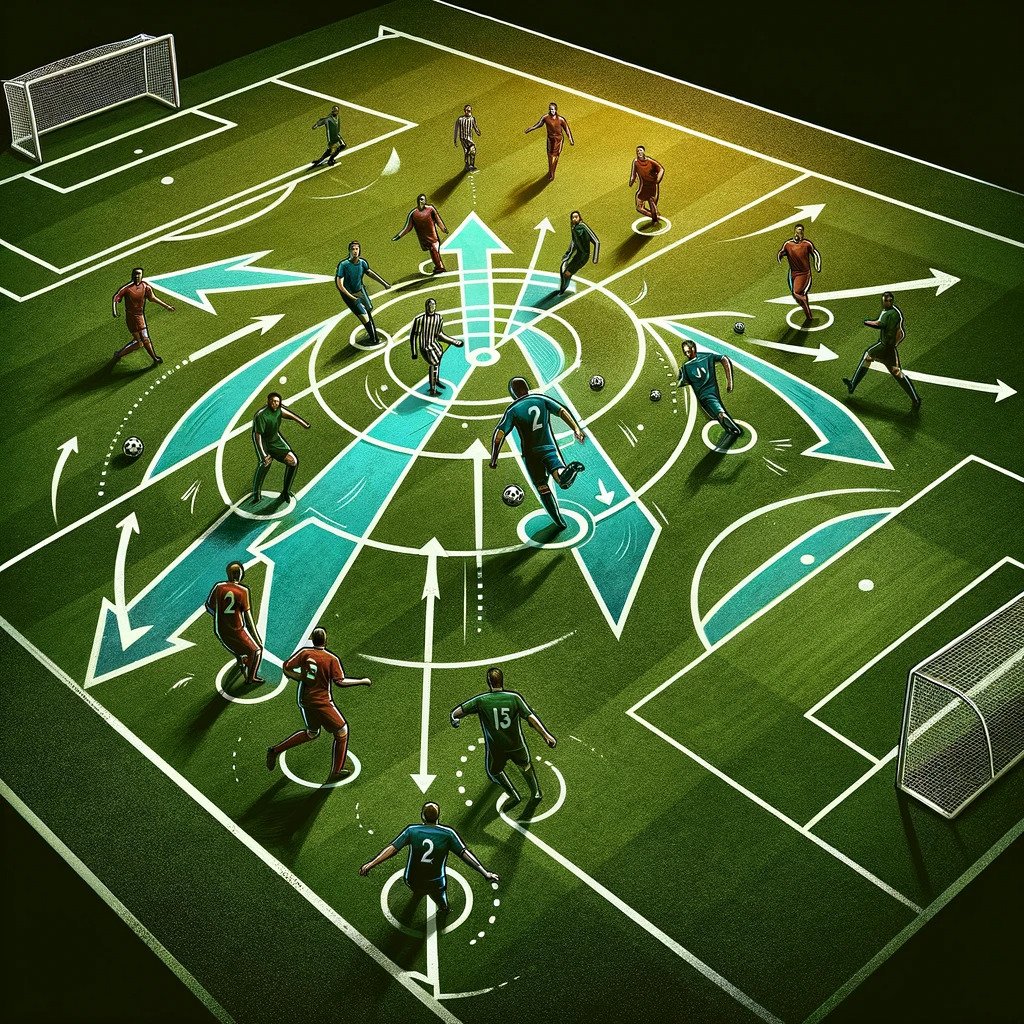In my years of coaching youth soccer, I’ve seen the soccer stopper position evolve. Traditionally, it was a common feature in the professional game, but now, it’s more seldomly used at that level. Instead, it has found its home in youth soccer, serving as an excellent tool to teach young players how to defend. This role is closely paired with the sweeper in the centre of defence. The stopper is expected to win every tackle and aerial challenge. They are the fearless warriors who are never afraid to put their body on the line, time and time again.
With the modern game placing an emphasis on centrebacks being comfortable on the ball, and starting moves from the back, the nature of the stopper’s role has shifted. They are now more aggressive compared to their counterpart central defenders.
A good stopper quickly applies pressure on the opposition’s strikers, nips in to intercept the ball, and stops dangerous moves in their tracks. Their ability to disrupt the flow of the opposition and stop a goal from being scored is paramount. They do everything possible to protect their team, embodying a spirit of resilience and determination.
The soccer teams of today demand stoppers who can intercept balls and transition quickly into attack, seamlessly integrating defense and offense. It’s a role that demands physical toughness, mental sharpness, and a relentless drive to defend the goal at all costs.
What is a stopper in soccer?
In soccer, the stopper is an essential role, typically filled by a center-back. This player lines up slightly in front of the other defenders, playing a crucial part in the team’s defensive strategy. Unlike traditional defenders, the stopper is often referred to as a pushed-up center back. Their primary function is to serve as the first line of defense, cleaning up attacks from the opposing team that manage to breach the central midfield. This positioning allows them to intercept and disrupt offensive plays early, safeguarding their team against potential threats.
The Hybrid Defender
The stopper acts like a unique hybrid of a center-back and a defensive midfielder. They serve as a defensive DMZ enforcer, strategically positioned between the midfield and the defensive third of the field. This dual role enables them to not only defend against attacks but also to initiate offensive plays from a deeper position.
Their versatility and ability to adapt to different situations make them an indispensable component of a well-rounded soccer team, bridging the gap between defense and midfield with agility and tactical awareness.
What Does a Stopper Do in Soccer?
The primary role of a stopper in soccer is to act as the backbone of the defense, primarily aimed to prevent the opposing team from scoring. This is achieved through marking and tackling the offensive players, effectively disrupting their attacking play. Stoppers are the unsung heroes who work tirelessly to ensure the safety of their goal, often shadowing the opposition’s most dangerous threats.
Tactical Responsibilities on the Field
A stopper’s specific responsibilities include marking and tracking the attacking players, making sure they do not get behind the defense. Their job extends beyond simple defense; they are involved in winning aerial duels, anticipating passes from midfielders, and intercepting crosses from wingers. Their presence on the field is a blend of foresight and physical prowess, designed to neutralize the opponent’s offensive strategies.
Communication and Defensive Harmony
Effective communication with other defenders is vital for a stopper. They play a significant role in organizing the defense and are often the pivot during counterattacks. Their ability to clear the ball out of danger and distribute it to midfielders or forwards when in possession is crucial. Acting as a safety net for the goalkeeper, stoppers ensure the defensive unit functions as a cohesive and impenetrable entity.
The Physical and Mental Attributes of a Stopper
Stoppers are expected to win tackles and headers, often putting in hefty challenges. They are the embodiment of the purest defensive role, where little emphasis is placed on their passing abilities. Their job is to fiercely contest every ball intended for the striker, exert enormous pressure, and stop any potential goalscoring opportunity. These players are intimidating and physical, known for their ability to contest and win every aerial challenge.
Strategy and Discipline
A successful stopper is not just about being aggressive in the tackle but also about maintaining discipline and positioning. They must anticipate the opponent’s moves, intercept passes, and limit the space and time in which the opposition can play. Timing is key to executing the perfect tackle or blocking shots. In essence, it’s their job to do everything possible to prevent their opponents from scoring.
Stopper positioning
In today’s soccer landscape, it has become increasingly rare to see professional teams line up with a traditional stopper and sweeper at the heart of their defence. This shift is due in large part to the demands of the modern game which places a greater emphasis on the ability to play out from the back and keep possession within the team. As a result, there’s less focus placed on the defensive abilities of defenders, who are now expected to be more cool, calm, and collected on the ball.
Youth Soccer’s Approach to Defense
However, in youth soccer, you will still find teams lining up with a stopper in defence. The stopper usually forms part of a back four, flanked by two fullbacks on either side and a sweeper slightly behind them.
This formation creates an almost diamond shape, where the stopper is the defender expected to contest each header, win every tackle, and be the first line of defense in cleaning up loose balls that get through. The reason many youth coaches decide to use this formation is that it helps young defenders learn how to defend and play out effectively, instilling essential skills for their progression in the sport.
Stopper Skills in Soccer

In soccer, Stoppers are known for their many roles and traits, but foremost among these is being Brave and Fearless. A stopper is expected to play as a disruptor to the offense’s strikers, guarding them closely and not allowing any space to score a goal. They must be fearless, willing to put their bodies on the line for the sake of the team, demonstrating a level of bravery that becomes the hallmark of their play.
Physical Strength and Intimidation
Being Strong and Intimidating is another key aspect of a stopper’s role. They are often a strong, physical player, aggressive in contesting every 50/50 ball that comes their way. Their presence involves shielding the offense and going shoulder-to-shoulder with the opposition to either win back the ball or make it a difficult shot on goal.
Discipline in Aggression
Despite their aggressive nature, Stoppers also need to be Disciplined. They should be careful not to commit “stupid” fouls that could lead to a penalty shot. This requires a lot of discipline and self-control, especially when an attacker gets past them. They must recover quickly and avoid blindly chasing the ball, as this can create openings for attackers to exploit.
Mastery of Field Awareness and Communication
Field Awareness and Communication Skills are crucial for Stoppers. Knowing one’s position on the field is obvious but especially important at the stopper position. In most cases, they are the last line of defense before the goalie. They need to know where the ball is at all times and be aware of off-ball attackers coming in.
Strategic Skills for Effective Play
A good stopper should have an excellent reading of the game, anticipation skills, tackling skills, strong ball control skills, and strength. They are often the ones to position themselves in front of the other defenders and clean up any attacks that breach the midfield.
The Role in Team Dynamics
Their ability to communicate with the goalkeeper, defenders, and midfielders makes a significant difference between a goal scored by the offense or a successful counter-attack. Their role is pivotal in not just defending but also in setting up the team for offensive plays.
Stopper jersey numbers
In the world of soccer, jersey numbers often carry a special significance, and this is particularly true for stoppers. Right stoppers traditionally wear the number four jersey, while their counterparts on the left side are identified with the number six. These numbers are more than mere identifiers; they symbolize the crucial roles these players hold on the field, each number carrying its own legacy and expectations.
The Evolving Role of Stoppers in Professional Soccer
However, in professional soccer, the usage of stoppers is rarely seen in the modern game. The numbers four and six are typically worn by defensive backs. This shift reflects the evolving strategies and formations in professional play, where the roles and responsibilities of positions are continually adapting to the dynamic nature of the sport.
Do Professional Soccer Teams Use Stoppers?

In contemporary professional soccer, the traditional use of stoppers has diminished significantly. Instead, these teams typically employ either 2 or 3 center backs in a flat line, moving away from the classic splitting of center backs into stopper/sweeper roles. This shift has occurred because soccer strategies have evolved quite a lot in the past decade.
Historically, teams would rely on their stoppers to prevent goal attempts, but modern strategies and formations now focus more on regaining ball possession. This evolution means that strikers and midfielders have often taken hybrid roles, and defensive positions no longer need to wait for the offense to cross the centerline before their defense “activates”.
Stoppers in Youth Soccer
Despite this evolution at the professional level, the stopper position remains fairly popular in high school and youth soccer leagues. For youth soccer teams, having a dedicated stopper is a great way to learn defense and stop the attack if the opposition is aggressive on offense.
This role is instrumental in teaching young players the fundamentals about positioning, making tackles, and communicating effectively on the field, providing a solid foundation for those aspiring to reach higher levels in the sport.
Conclusion
While the soccer stopper position has seen a shift in its application and relevance, especially at the professional level, its fundamental principles remain vital in the development of young players. Stoppers teach essential skills such as positioning, tactical awareness, and robust defense, forming a crucial part of a player’s soccer education.
Even as professional teams evolve to embrace more fluid and versatile defensive strategies, the teachings and experiences gained from playing as a stopper in youth and high school soccer continue to shape well-rounded, defensively astute players. The soccer stopper position, therefore, remains a testament to the sport’s evolving nature while retaining its essence in teaching the art of defense.
Frequently asked questions about soccer stopper position
What is the difference between a stopper and a sweeper in soccer?
The main difference lies in their defensive roles and positioning. A stopper plays in front of the sweeper, primarily focusing on intercepting passes and marking strikers, preventing them from advancing towards the goal. The sweeper, on the other hand, plays behind the defensive line, acting as the last line of defense before the goalkeeper. They are responsible for cleaning up any balls that get past the stopper and other defenders.
What is left defense called in soccer?
In soccer, the left defense position is commonly referred to as the left-back or left fullback. This position requires players to defend against the opposition’s attacks down the left flank and also support their own team’s offensive play when possible.
What is an example of a stopper?
A classic example of a stopper in soccer is a central defender who excels at breaking up opposition attacks, often through strong tackling, aerial duels, and close marking of key opposition players. For instance, a player who effectively blocks shots, intercepts passes, and consistently halts the forward momentum of attacking strikers embodies the qualities of a stopper.
How many types of stopper are there?
In soccer, the term “stopper” generally refers to one type of player – the central defender with a focus on disrupting the opposition’s attacks. However, the role can vary slightly based on team tactics, such as a more aggressive stopper who pushes up the field versus a more defensive-minded one who stays back to guard against counter-attacks.
What is stopper mechanism?
In the context of soccer, the term “stopper mechanism” isn’t a standard term. However, it could conceptually refer to the defensive strategies and tactics employed by a stopper to halt or disrupt the offensive play of the opposing team. This includes positioning, decision-making, and specific actions like tackling and intercepting to prevent the opposition from scoring.

